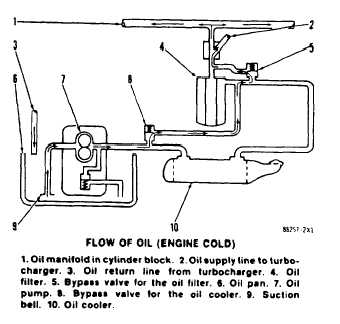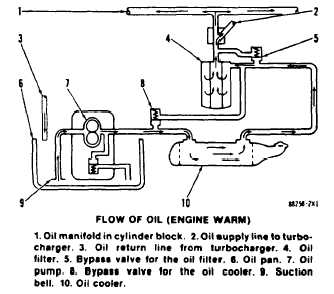LUBRICATION SYSTEM
TM 5-3805-263-34&P-2
OIL FLOW THROUGH THE OIL FILTER
AND OIL COOLER
With the engine warm (normal operation), oil
comes from the oil pan (6) through the suction bell
(9) to the oil pump (7). The oil pump sends warm oil
to the oil cooler (10) and then to the oil filter (4).
From the oil filter. oil is sent to the oil manifold (1) in
the cylinder block and to the oil supply line (2) for the
turbocharger. Oil from the turbocharger goes back
through the oil return line (3) to the oil pan,
With the engine cold (starting conditions), oil
comes from the oil pan (6) through the suction bell
(9) to the oil pump (7). When the oil is cold, an oil
pressure difference in the bypass valve (installed in
the oil filter housing) causes the valves to open. These
bypass valves give immediate lubrication to all com-
ponents when cold oil with high viscosity causes a
restriction to the oil flow through the oil cooler (10)
and oil filter (4). The oil pump then sends the cold oil
through the bypass valve for the oil cooler (8) and
through the bypass valve for the oil filter (5) to the oil
manifold (1) in the cylinder block and to the supply
line (2) for the turbocharger. Oil from the turbo-
charger goes back through the oil return line (3) to
the oil pan.
When the oil gets warm, the pressure difference in
the bypass valves decreases and the bypass valves
close. Now there is a normal oil flow through the oil
cooler and oil filter.
The bypass valves will also open when there is a
restriction in the oil cooler or oil filter. This action
does not let an oil cooler or oil filter with a restriction
prevent the lubrication of the engine.
1-16
SYSTEMS OPERATION
OIL FLOW IN THE ENGINE
There is a bypass valve in the oil pump. This
bypass valve controls the pressure of the oil coming
from the oil pump. The oil pump can put more oil into
the-system than is needed. When there is more oil
than needed, the oil pressure goes up and the bypass
valve opens. This lets the oil that is not needed go
back to the oil pan.
The output of the oil pump goes to the oil manifold
in the cylinder block. The oil manifold is the source of
oil under pressure for the engine and its attachments.
From the oil manifold in the cylinder block, oil
is sent through drilled passages in the cylinder block
that connect the main bearing!, and the camshaft
bearings. Oil goes through drilled holes in the
crankshaft to give lubrication to the connecting
rod bearings.
Oil goes out through piston cooling orifices in the
block. These orifices are between cylinders 1 and 2
and between cylinders 3 and 4, near the main bear-
ings. The oil cools the pistons and helps lubricate
the pistons, piston pins, cylinder walls and piston
rings.
Oil is sent through passages to the rocker arm
shaft. Holes in the rocker arm shafts let the oil give
lubrication to the valve system components in the
cylinder head.
The oil supply passage for the rocker arms has an
oil passage from the rear of the cylinder block that
goes below the head bolt hole and connects with a
drilled passage in the cylinder block to the oil pas-
sage in the head. The spacer plate has a hole with a



